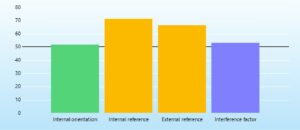Quality- 09.06.2022
Validation
Introduction to quality standards and intended use
Internationally, as well as in the German-speaking world, there is an immense number of tests and measurement procedures that can be used to assess personality, behaviour, characteristics, attitudes, performance, motives, motivation, learning behaviour, social skills and much more.
A distinction must be made between sound procedures that are based on scientific principles and constructed according to generally accepted scientific standards and pseudoscientific or dubious procedures.
For laypersons, choosing the right tool is sometimes difficult. In addition, well-founded tools that are used for objectives that do not fit are hardly useful.

Focus on changable variables
The use of well-founded tools can be useful, provided that there is a corresponding objective of the participating persons and the methodological competence of the coach to select the appropriate tool.
In this context, the unreflective use of personality tests must be evaluated critically, since – as evidenced by the Big Five model of personality psychology, for example – personality traits can be regarded as stable after the age of 30.
However, L&D support focuses on changeable variables. In this respect, the use of personality-based methods is only partially effective.
To capture the variables that are also changeable, the L&D Support Tool provides support. It is based on scientific principles. The underlying model of the L&D Support tool is not a static personality model, but is based on several scientifically founded psychological theories.
For more information on scientifically based psychological theories of our tool click here –> Download Section
Scientific principals
The development and validation of the L&D Support tool was based on scientific theories and selected aspects of psychological concepts, which have been incorporated into its model.
The scientific principles and theories presented are generally recognised as sound and their validity has been proven by numerous studies. Internationally defined standards are used to assess psychological evaluation procedures.
For this purpose, the BoA (EFPA Board of Assessment) has published a Test Review Model, which serves as a standard for the assessment of tests throughout Europe.
These are checked by independent certified auditors on the basis of corresponding test quality criteria. Test quality criteria are criteria that provide information about how good a psychological test or measurement procedure is.
In total, there are three criteria:
objectivity, reliability and validity.
Objectivity (independence):
Measurement procedures can be falsified by human influence.
In order to guarantee the quality and significance of the results, it is important to design the implementation, evaluation and interpretation of tests in a non-judgemental and independent manner.
Objectivity can be divided into three areas: Implementation objectivity, evaluation objectivity and interpretation objectivity.
In all three areas, the objectivity of the measurement procedure ensures an equal procedure independent of the test taker and test subject.

Reliability (accuracy):
The term ‘reliability’ refers to the accuracy of measurement.
The main concern here is that results cannot be altered by inaccuracy. Accurate measurements also produce accurate and reliable results.
Reliability is measured by means of Cronbach’s alpha (measurement of consistency).

Validity:
While reliability and objectivity focus on measurement accuracy, validity focuses on the validity of the measurement result.
Validity is therefore the premise for reliability (Cronbach’s alpha) and objectivity from which the quality of a test procedure is derived.
The consistency of the content of the measurement with a logical measurement concept must be demonstrated, so that it is proven that the characteristic to be measured is actually measured.
The evidence on objectivity and reliability serves this purpose. For more information on the test quality criteria click Continue.